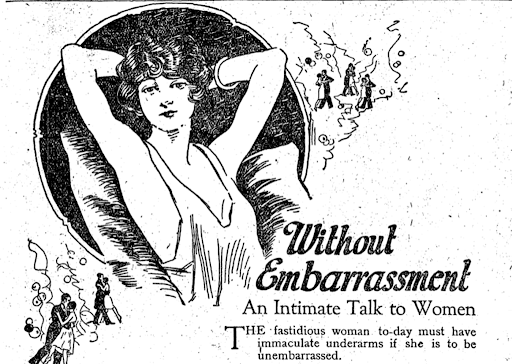Body hair? don’t care

Ads for shaving appeal to women by exploiting their insecurities regarding their body hair. This ad was released in 1922 and helped to further entrench the hairless beauty standard.
Hot wax, lasers, razors—different tools women use every day to remove hair in areas deemed undesirable for women: legs, underarms, bikini line, and even stomach, back, and feet. But why? To achieve a double standard that dates back to the 1940’s.
Prior to this time, hardly any women shaved. But advertisements in the media perpetuated the idea that body hair on women is something to be embarrassed and insecure about.
In 1941, the beauty editor of Harper’s Bazaar said: “If we were the dean of women, we would levy a demerit on every hairy leg on campus.”
Women were taught to be ashamed of their body hair, so shaving companies capitalized on these insecurities and helped entrench the rigid hairless standard as an integral part of their marketing strategy.
When Gillette, a razor company, advertised men’s razors, they focused on the quality of the razors and the feeling of shaving. But their advertisements for women’s razors in 1917 said that having body hair as a woman was an “embarrassing personal problem,” while simultaneously promoting their products as the solution.
These marketing campaigns coincided with hairless women modeling fashion trends that started to show more skin, causing the spread of the hairless beauty standard to take hold.
According to Brooke McCord of Dazed Digital magazine, in 2012, 92 percent of women between the ages of 18-24 shaved their legs. But in 2016, this number decreased to 85 percent and continues to decline.
The media greatly influenced this change, and it continues to play a large role in society’s perception of body hair on women. Commercials are moving away from portraying unrealistic shaving routines, where women are shown shaving their already hairless skin. Today’s ads and marketing now focus more on empowerment and choice. Women are encouraged to reconsider the reasons why they shave, and whether they are actually choosing to shave or being pressured to achieve a societal standard.
Growing up surrounded by other girls who started shaving as early as the third grade, I felt the peer pressure to fit in. I tried to persuade my parents to let me shave so that I could better blend in with the other girls, but they told me that it was better to wait. As a result, I would wear pants year-round, even if it was 90 degrees outside, and long socks quickly became my best friend.
But I never took a step back to ask myself, “Why should I feel insecure about this?”
Now, I’m thankful that my parents told me to wait. I eventually grew out of my need to conform, and I never ended up shaving.
I also no longer have the desire to shave. I find body hair removal routines to be time-consuming, and I can still achieve my own standard of beauty, hairless or not. To this day, I still have no idea how to use a razor and have zero desire to learn.
Even though there are other women who believe the same as I do, body hair removal in today’s society is still the norm and a large part of the beauty industry. But women have been unlearning what they were historically taught about how being hairless equates to femininity and beauty.
Hopefully with time, women removing their body hair to meet an outdated beauty standard will be replaced by a new norm where a woman’s choice to achieve her sense of beauty and self—whatever that may be—is celebrated and revered.

Alexa Fo is the news editor and a junior at Monte Vista. She was the feature editor for The Stampede...





